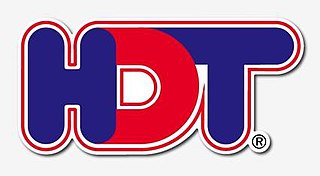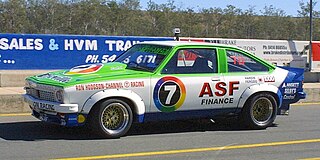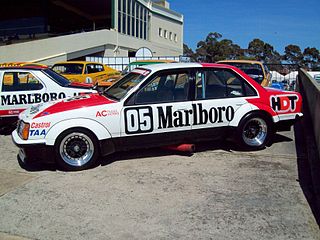The Australian Touring Car Championship (ATCC) is a touring car racing award held in Australia since 1960. The series itself is no longer contested, but the title lives on, with the winner of the Repco Supercars Championship awarded the trophy and title of Australian Touring Car Champion.

The Holden Dealer Team (HDT) was Holden's semi-official racing team from 1969 until 1986, primarily contesting Australian Touring Car events but also rallying, rallycross and Sports Sedan races during the 1970s. From 1980 the Holden Dealer Team, by then under the ownership of Peter Brock, diversified into producing modified road-going Commodores and other Holden cars for selected dealers via HDT Special Vehicles.
The 1974 RE-PO 500K was an endurance race for Group C Touring Cars. It was held at the Phillip Island Circuit in Victoria, Australia on 24 November 1974 over 106 laps, a race distance of 501 kilometres (311 mi). The race, which was the fifth round of the 1974 Australian Manufacturers' Championship, was the fourth annual "Phillip Island 500K".

The 1975 Hardie-Ferodo 1000 was the 16th running of the Bathurst 1000 touring car race. It was an endurance race for touring cars complying with CAMS Group C regulations. The event was held at the Mount Panorama Circuit just outside Bathurst, New South Wales on 5 October 1975 over a distance of 1006.036 km. The race was Round 3 of the 1975 Australian Manufacturers' Championship.
The 1981 Australian Touring Car Championship was a CAMS sanctioned motor racing title for drivers of Group C Touring Cars. The championship, which was the 22nd running of the Australian Touring Car Championship, began at Symmons Plains Raceway and ended at Lakeside International Raceway after 8 rounds.

In relation to Australian motorsport, Group C refers to either of two sets of regulations devised by the Confederation of Australian Motor Sport (CAMS) for use in Australian Touring Car Racing from 1965 to 1984. These are not to be confused with the FIA's Group C sports car regulations, used from 1982 to 1992 for the World Endurance Championship / World Sports-Prototype Championship / World Sportscar Championship and the 24 Hours of Le Mans.
The 1987 Australian Touring Car Championship was a motor racing competition which was open to Touring Cars complying with regulations as defined by the Confederation of Australian Motor Sport and based on FIA Group A rules. The championship, which was the 28th Australian Touring Car Championship, began on 1 March 1987 at Calder Park Raceway and ended on 5 July at Oran Park Raceway after nine rounds. The Calder round saw the world debut of the racing versions of the BMW M3, the Ford Sierra RS Cosworth and the Alfa Romeo 75 Turbo.

The 1979 Hardie-Ferodo 1000 was the 20th running of the Bathurst 1000 touring car race. It was held on 30 September 1979, at the Mount Panorama Circuit just outside Bathurst. The race was open to cars eligible to the locally developed CAMS Group C touring car regulations with four engine capacity based classes.
The 1988 Australian Touring Car Championship was a CAMS sanctioned motor racing title for drivers of Group 3A Touring Cars. It was the 29th running of the Australian Touring Car Championship. The championship began on 6 March at Calder Park Raceway and ended on 17 July at Oran Park Raceway after nine rounds.
The 1985 Australian Touring Car Championship was a CAMS sanctioned motor racing title for drivers of Touring Cars. It was the 26th running of the Australian Touring Car Championship and the first to be contested using regulations based on the FIA's International Group A regulations after having been run under CAMS home grown Group C rules between 1973 and 1984. The championship began on 10 February 1985 at Winton Motor Raceway and ended on 14 July at Oran Park Raceway after ten rounds.
The 1979 Australian Touring Car Championship was a CAMS sanctioned Australian motor racing title open to Group C Touring Cars. It began at Symmons Plains and ended at Adelaide International Raceway after eight rounds. The title, which was the 20th Australian Touring Car Championship, was won by Bob Morris driving a Holden Torana.
The 1982 Australian Touring Car Championship was a CAMS sanctioned Australian motor racing title open to Group C Touring Cars. It began on 18 February 1982 at Sandown Raceway and ended on 16 May at Oran Park Raceway after eight rounds. The title, which was the 23rd Australian Touring Car Championship, was won by defending champion Dick Johnson, driving a Ford XD Falcon.

The 1983 Australian Touring Car Championship was a CAMS sanctioned motor racing title for drivers of Group C Touring Cars. The title, which was the 24th Australian Touring Car Championship, was contested over a series which began on 6 February 1983 at Calder Park Raceway and ended on 19 June at Lakeside International Raceway after eight rounds.
The 1978 Australian Touring Car Championship was a CAMS sanctioned Australian motor racing title open to Group C Touring Cars. The title, which was the 19th Australian Touring Car Championship, was won by Peter Brock. It was his second Australian Touring Car Championship victory.
The 1977 Australian Touring Car Championship was a CAMS sanctioned Australian motor racing championship open to Group C Touring Cars. It was the 18th running of the Australian Touring Car Championship. The championship began at Symmons Plains Raceway on 7 March and ended at the Phillip Island Grand Prix Circuit on 20 November after eleven rounds. 1977 was the second and final time that the series incorporated the longer distance races which made up the Australian Championship of Makes. These races included the Sandown 400 and the Phillip Island 500K, although notably not the Bathurst 1000.
The 1976 Australian Touring Car Championship was a CAMS sanctioned Australian motor racing title for Group C Touring Cars. It was the 17th running of the Australian Touring Car Championship. The championship began at Symmons Plains on 29 February and ended at Phillip Island on 28 November in the longest season in the history of the series. 1976 saw a substantial change to the ATCC calendar which was expanded to eleven rounds, incorporating the end-of-season long distance Australian Championship of Makes races for the first time. These races included Sandown's Hang Ten 400 and the Phillip Island 500, although notably not the Bathurst 1000.
The 1975 Australian Touring Car Championship was a CAMS sanctioned Australian motor racing title open to Group C Touring Cars. The championship began at Symmons Plains and ended at Lakeside after seven rounds. It was the 16th Australian Touring Car Championship.

The 1980 Australian Touring Car Championship was an Australian motor racing competition for Group C Touring Cars. Authorised by the Confederation of Australian Motor Sport as a National Title, it was the 21st Australian Touring Car Championship.
AMSCAR was a touring car series held in Australia between 1979 and 1997, based at Amaroo Park in Sydney.
The 1979 Australian Championship of Makes was a CAMS sanctioned Australian motor racing title open to Group C Touring Cars. It was the ninth manufacturers’ title to be awarded by CAMS and the fourth to carry the Australian Championship of Makes name. The title was awarded to Holden.




